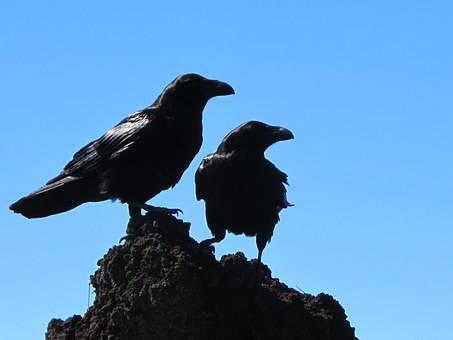
A Murder of Crows, Part 2
I peered into our once-thriving orchard that bore fewer avocado trues since the drought began. There I spotted a black object lying in the dirt. At first I thought a plastic trash bag had been tossed over the fence. As I moved closer, I realized that this was not a trash bag but an animal’s carcass. Could it be a neighbor’s cat? It looked too large.
I opened the orchard gate, descending the railroad-tie steps down the steep slope unsure of what I’d find. When I reached the bottom, I waded through the piles of dead leaves and discovered a second black object—the body of a crow. I climbed the hill to where the first carcass lay and realized it was another crow. I could not tell what killed them until I saw punctures on one’s neck and its empty eye sockets.
Poor Heckle and Jeckle, I thought. Yes, they were annoying, but they certainly did not deserve to be killed and left. The sight of them lying there dead upset me. I walked back to the house and told Don what I found.
“Hawks are bird of prey,” he noted. “Sometimes they hunt to eat and other times they just kill.”
Shortly afterwards, our gardening team arrived for weekly maintenance. When you live on an acre of land, you need help. I told them about my discovery, and the gardener’s son stepped forward and said, “I’ll help you bury them. Let me get my shovel.”
Until that morning, I’d never been particularly impressed with this young man. He did not seem to enjoy his work, and I suspected he had been forced into his profession by his parents, who worked alongside him. Together, we went down to the orchard. “Yup, it was definitely a hawk,” he said. “Look at the marks on their necks.” Then he dug two deep holes in the corner of the orchard, and we chatted about his weekend and various things while he labored away. Finally, he carefully lifted each bird into its respective grave. As he covered the graves with dirt, he said, “God be with you,” while I silently said a prayer. That morning I gained new respect for this young man.
Yet I still felt the crows’ deaths were a bad omen, and the thought gnawed at me all day. Finally, I searched for “symbolism of dead crows” on my computer. To my surprise, two answers came up. Dead crows can be messengers of death or messengers of change. I’d experienced enough death, especially during the month of May, to hope for the latter. I chose messengers of change as the meaning I would embrace.
I spent the entire day writing for the first time in months. It felt great to be doing what I loved most after a long hiatus. Perhaps these deaths, as the deaths of many loved ones, had been my inspiration.
Years ago when Don and I ventured to Africa, our tour guide identified the animals we’d see. Then she stated the monikers that defined a group of each particular animal and gave us a list. For example, we saw a pride of lions, a zeal of zebras, a parade of elephants, a thunder of hippopotami, a leap of leopards, a troop of baboons, a tower of giraffes, a cackle of hyenas, and a pot of water buffaloes. But we never saw a murder of crows.
I found one in my own back yard.
